2011 HYUNDAI VERACRUZ emergency towing
[x] Cancel search: emergency towingPage 292 of 419
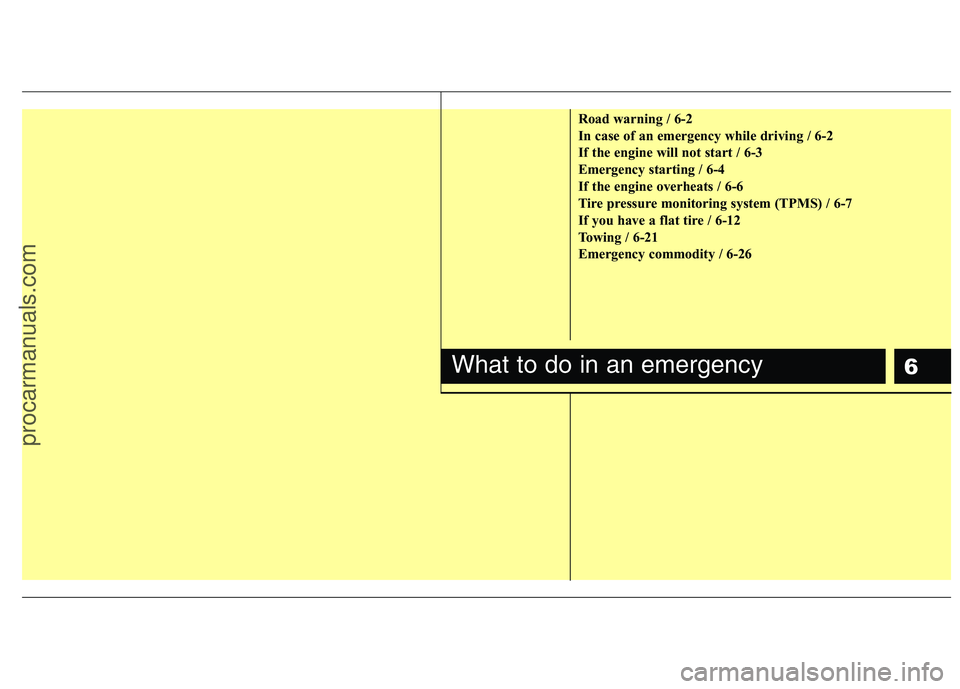
6
Road warning / 6-2
In case of an emergency while driving / 6-2
If the engine will not start / 6-3
Emergency starting / 6-4
If the engine overheats / 6-6
Tire pressure monitoring system (TPMS) / 6-7
If you have a flat tire / 6-12
Towing / 6-21
Emergency commodity / 6-26
What to do in an emergency
procarmanuals.com
Page 295 of 419
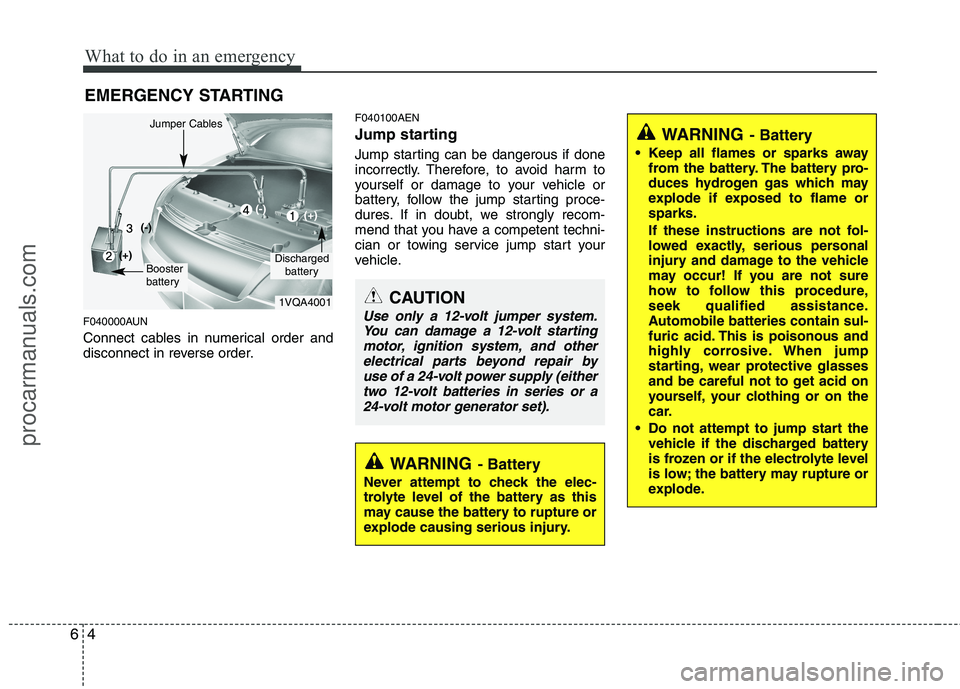
What to do in an emergency
4
6
EMERGENCY STARTING
F040000AUN
Connect cables in numerical order and
disconnect in reverse order. F040100AEN
Jump starting
Jump starting can be dangerous if done
incorrectly. Therefore, to avoid harm to
yourself or damage to your vehicle or
battery, follow the jump starting proce-
dures. If in doubt, we strongly recom-
mend that you have a competent techni-
cian or towing service jump start your
vehicle.
CAUTION
Use only a 12-volt jumper system.
You can damage a 12-volt starting
motor, ignition system, and otherelectrical parts beyond repair by use of a 24-volt power supply (eithertwo 12-volt batteries in series or a24-volt motor generator set).
WARNING - Battery
• Keep all flames or sparks away from the battery. The battery pro-
duces hydrogen gas which may
explode if exposed to flame orsparks.
If these instructions are not fol-
lowed exactly, serious personal
injury and damage to the vehicle
may occur! If you are not sure
how to follow this procedure,
seek qualified assistance.
Automobile batteries contain sul-
furic acid. This is poisonous and
highly corrosive. When jump
starting, wear protective glasses
and be careful not to get acid on
yourself, your clothing or on the
car.
Do not attempt to jump start the vehicle if the discharged battery
is frozen or if the electrolyte level
is low; the battery may rupture or
explode.
WARNING - Battery
Never attempt to check the elec-
trolyte level of the battery as this
may cause the battery to rupture or
explode causing serious injury.
1VQA4001
Discharged battery
Jumper Cables
Booster
battery
(-)
(+)
(+)(-)
procarmanuals.com
Page 312 of 419
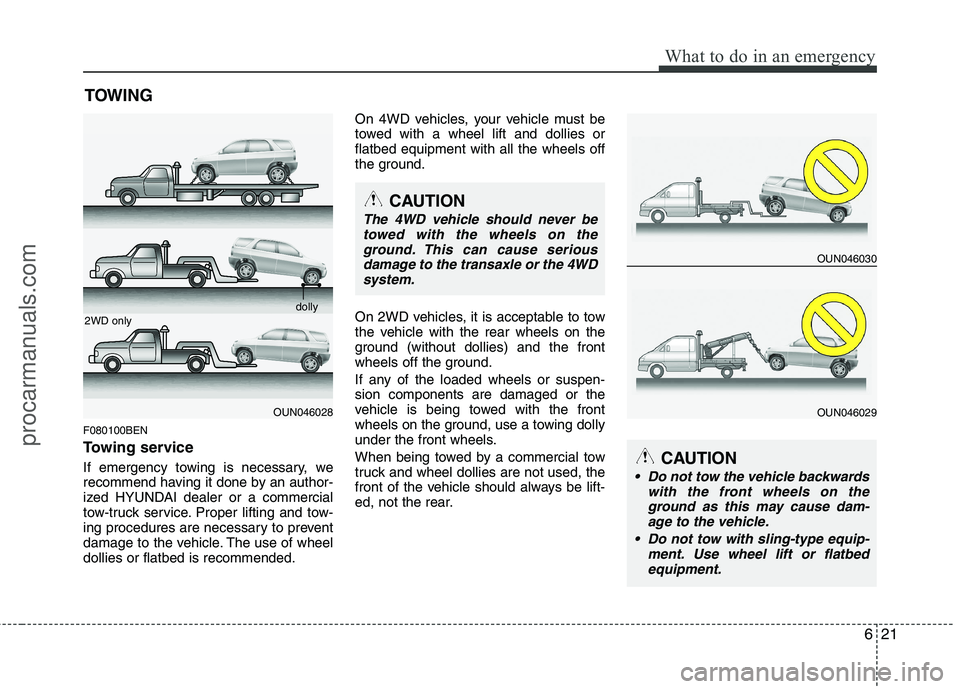
621
What to do in an emergency
TOWING
F080100BEN
Towing service
If emergency towing is necessary, we
recommend having it done by an author-
ized HYUNDAI dealer or a commercial
tow-truck service. Proper lifting and tow-
ing procedures are necessary to prevent
damage to the vehicle. The use of wheeldollies or flatbed is recommended. On 4WD vehicles, your vehicle must be
towed with a wheel lift and dollies orflatbed equipment with all the wheels off
the ground.
On 2WD vehicles, it is acceptable to tow
the vehicle with the rear wheels on the
ground (without dollies) and the front
wheels off the ground.
If any of the loaded wheels or suspen- sion components are damaged or the
vehicle is being towed with the front
wheels on the ground, use a towing dolly
under the front wheels.
When being towed by a commercial tow
truck and wheel dollies are not used, the
front of the vehicle should always be lift-
ed, not the rear.
OUN046028
OUN046030
OUN046029
CAUTION
Do not tow the vehicle backwards
with the front wheels on theground as this may cause dam-
age to the vehicle.
Do not tow with sling-type equip- ment. Use wheel lift or flatbedequipment.
CAUTION
The 4WD vehicle should never be towed with the wheels on theground. This can cause serious
damage to the transaxle or the 4WDsystem.
dolly2WD only
procarmanuals.com
Page 313 of 419

What to do in an emergency
22
6
When towing your vehicle in an emer- gency without wheel dollies :
1. Set the ignition switch in the ACC posi-
tion.
2. Place the transaxle shift lever in N (Neutral).
3. Release the parking brake.
F080200AUN
Removable towing hook (rear) (if equipped)
1. Open the tailgate, and remove the tow-ing hook from the tool case.
2. Remove the hole cover pressing the lower part of the cover on the rear
bumper. 3. Install the towing hook by turning it
clockwise into the hole until it is fullysecured.
4. Remove the towing hook and install the cover after use.
CAUTION
Failure to place the transaxle shift
lever in N (Neutral) may cause inter-nal damage to the transaxle.
OEN066010OEN066011
procarmanuals.com
Page 314 of 419
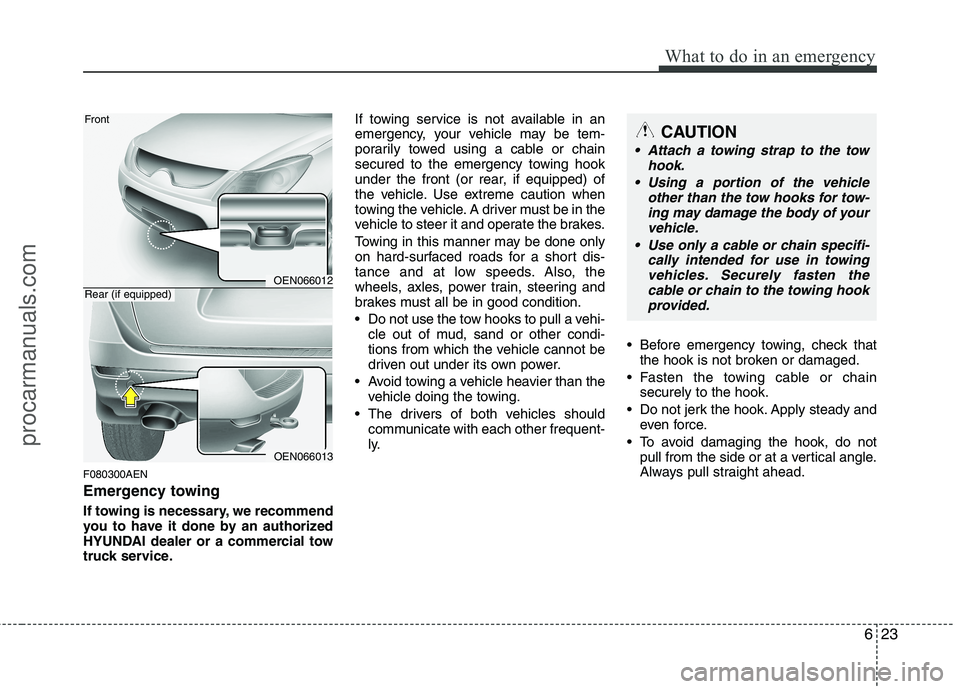
623
What to do in an emergency
F080300AEN
Emergency towing
If towing is necessary, we recommend
you to have it done by an authorized
HYUNDAI dealer or a commercial tow
truck service.If towing service is not available in an
emergency, your vehicle may be tem-
porarily towed using a cable or chain
secured to the emergency towing hook
under the front (or rear, if equipped) of
the vehicle. Use extreme caution when
towing the vehicle. A driver must be in the
vehicle to steer it and operate the brakes.
Towing in this manner may be done only
on hard-surfaced roads for a short dis-
tance and at low speeds. Also, the
wheels, axles, power train, steering and
brakes must all be in good condition.
Do not use the tow hooks to pull a vehi-
cle out of mud, sand or other condi-
tions from which the vehicle cannot be
driven out under its own power.
Avoid towing a vehicle heavier than the vehicle doing the towing.
The drivers of both vehicles should communicate with each other frequent-
ly. Before emergency towing, check that
the hook is not broken or damaged.
Fasten the towing cable or chain securely to the hook.
Do not jerk the hook. Apply steady and even force.
To avoid damaging the hook, do not pull from the side or at a vertical angle.
Always pull straight ahead.
OEN066012
OEN066013
Front
Rear (if equipped)
CAUTION
Attach a towing strap to the tow
hook.
Using a portion of the vehicle other than the tow hooks for tow-ing may damage the body of yourvehicle.
Use only a cable or chain specifi- cally intended for use in towingvehicles. Securely fasten thecable or chain to the towing hookprovided.
procarmanuals.com
Page 315 of 419
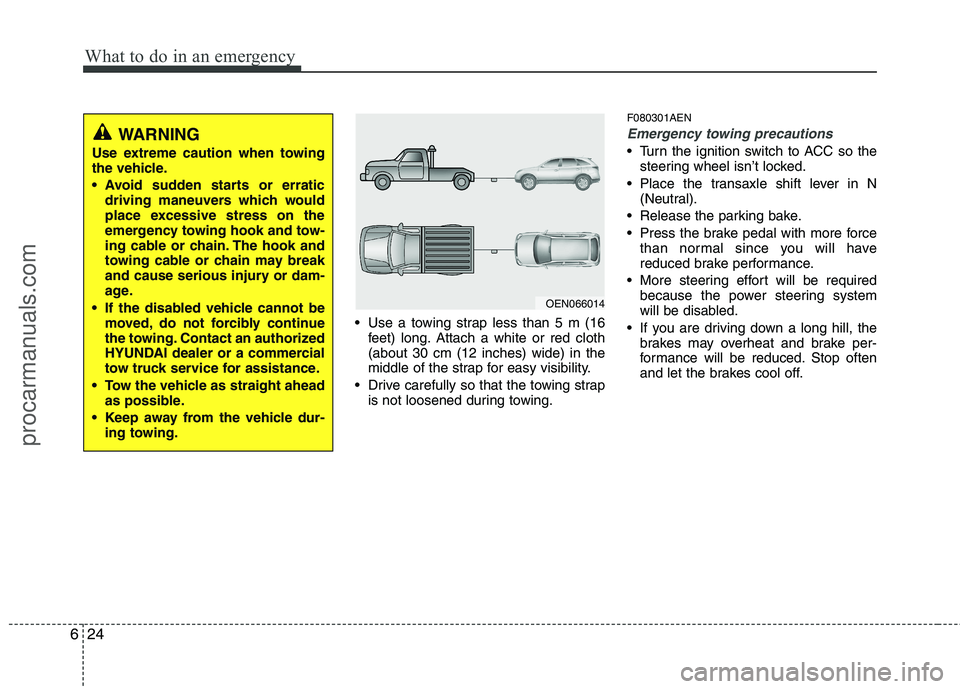
What to do in an emergency
24
6
Use a towing strap less than 5 m (16
feet) long. Attach a white or red cloth (about 30 cm (12 inches) wide) in the
middle of the strap for easy visibility.
Drive carefully so that the towing strap is not loosened during towing. F080301AEN
Emergency towing precautions
Turn the ignition switch to ACC so the
steering wheel isn’t locked.
Place the transaxle shift lever in N (Neutral).
Release the parking bake.
Press the brake pedal with more force than normal since you will have
reduced brake performance.
More steering effort will be required because the power steering system
will be disabled.
If you are driving down a long hill, the brakes may overheat and brake per-
formance will be reduced. Stop often
and let the brakes cool off.
WARNING
Use extreme caution when towing
the vehicle.
driving maneuvers which would
place excessive stress on the
emergency towing hook and tow-
ing cable or chain. The hook and
towing cable or chain may break
and cause serious injury or dam-
age.
If the disabled vehicle cannot be moved, do not forcibly continue
the towing. Contact an authorized
HYUNDAI dealer or a commercial
tow truck service for assistance.
Tow the vehicle as straight ahead as possible.
Keep away from the vehicle dur- ing towing.
OEN066014
procarmanuals.com
Page 316 of 419
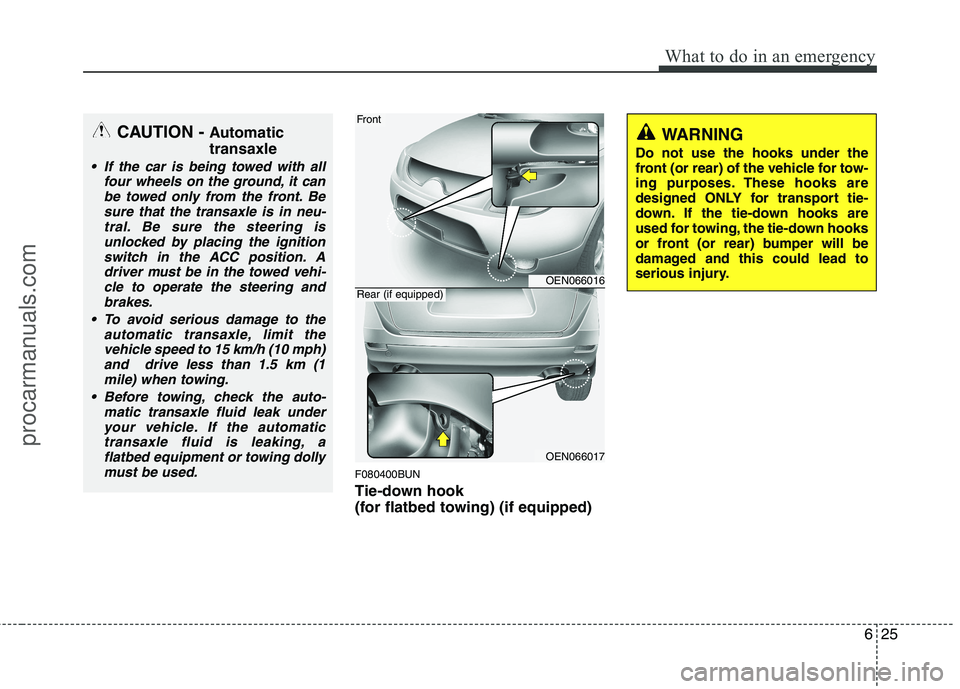
625
What to do in an emergency
F080400BUN
Tie-down hook
(for flatbed towing) (if equipped)
CAUTION - Automatic transaxle
If the car is being towed with all
four wheels on the ground, it can
be towed only from the front. Besure that the transaxle is in neu-tral. Be sure the steering is unlocked by placing the ignition
switch in the ACC position. Adriver must be in the towed vehi- cle to operate the steering and
brakes.
To avoid serious damage to the automatic transaxle, limit thevehicle speed to 15 km/h (10 mph)and drive less than 1.5 km (1
mile) when towing.
Before towing, check the auto- matic transaxle fluid leak underyour vehicle. If the automatic transaxle fluid is leaking, a
flatbed equipment or towing dollymust be used.
WARNING
Do not use the hooks under the
front (or rear) of the vehicle for tow-
ing purposes. These hooks are
designed ONLY for transport tie-
down. If the tie-down hooks are
used for towing, the tie-down hooks
or front (or rear) bumper will be
damaged and this could lead to
serious injury.
OEN066016
OEN066017
Front
Rear (if equipped)
procarmanuals.com
Page 413 of 419
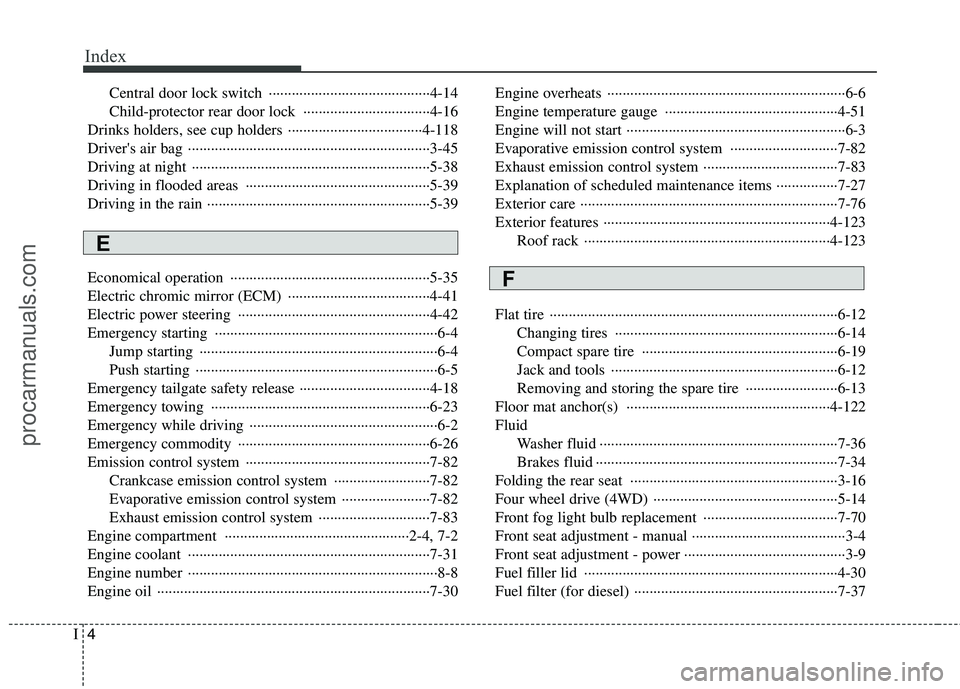
Index
4
I
Central door lock switch ··········································4-14
Child-protector rear door lock ·································4-16
Drinks holders, see cup holders ···································4-118
Driver's air bag ·······························································3-45
Driving at night ······························································5-38
Driving in flooded areas ················································5-39
Driving in the rain ··························································5-39
Economical operation ····················································5-35
Electric chromic mirror (ECM) ·····································4-41
Electric power steering ··················································4-42
Emergency starting ··························································6-4 Jump starting ······························································6-4
Push starting ·······························································6-5
Emergency tailgate safety release ··································4-18
Emergency towing ·························································6-23
Emergency while driving ·················································6-2
Emergency commodity ··················································6-26
Emission control system ················································7-82 Crankcase emission control system ·························7-82
Evaporative emission control system ·······················7-82
Exhaust emission control system ·····························7-83
Engine compartment ················································2-4, 7-2
Engine coolant ·······························································7-31
Engine number ·································································8-8
Engine oil ·······································································7-30 Engine overheats ······························································6-6
Engine temperature gauge ·············································4-51
Engine will not start ·························································6-3
Evaporative emission control system ····························7-82
Exhaust emission control system ···································7-83Explanation of scheduled maintenance items ················7-27
Exterior care ···································································7-76
Exterior features ···························································4-123
Roof rack ································································4-123
Flat tire ···········································································6-12 Changing tires ··························································6-14
Compact spare tire ···················································6-19
Jack and tools ···························································6-12
Removing and storing the spare tire ························6-13
Floor mat anchor(s) ·····················································4-122Fluid Washer fluid ······························································7-36
Brakes fluid ·······························································7-34
Folding the rear seat ······················································3-16
Four wheel drive (4WD) ················································5-14
Front fog light bulb replacement ···································7-70Front seat adjustment - manual ········································3-4
Front seat adjustment - power ··········································3-9
Fuel filler lid ··································································4-30
Fuel filter (for diesel) ·····················································7-37
E
F
procarmanuals.com